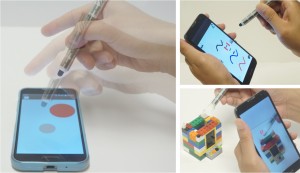Abstract: We present TMotion, a self-contained 3D input that enables spatial interactions around mobile device using a magnetic sensing technique. We embed a permanent magnet and an inertial measurement unit (IMU) in a stylus. When the stylus moves around the mobile device, we obtain a continuous magnetometer readings. By numerically solving non-linear magnetic field equations with known orientation from IMU, we achieve 3D position tracking with update rate greater than 30Hz. Our experiments evaluated the position tracking accuracy, showing an average error of 4.55mm in the space of 80mm—120mm—100mm. Furthermore, the experiments confirmed the tracking robustness against orientations and dynamic tracings. In task evaluations, we verified the tracking and targeting performance in spatial interactions with users. We demonstrate example applications that highlight TMotion’s interaction capability.


